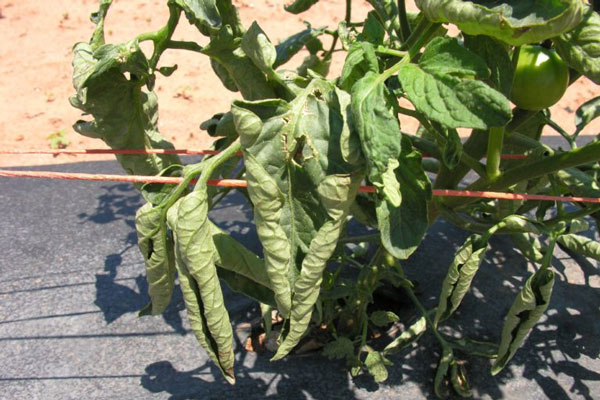Taking an environmentally sensitive approach to pest management
Tomato Leaf Curl
Published: July 3, 2019

credit: Dr. Joey Williamson, Clemson University.
Gardeners tend to be a worrisome group, showing great concern over anything unusual about their plants. This especially is true for their tomato crop, which tends to be the pride and joy of nearly every serious gardener. It comes with little surprise, therefore, that many gardeners at this time of the year ask, with utmost concern, "Why are the leaves of my tomato plants curling?"
The leaves of tomato plants can curl (or roll) for a number of reasons. Some are more serious than others. Abnormal growth is a classic symptom caused by many virus diseases. In tomato, there are several virus diseases (e.g. curly top) that cause "twisted" growth especially of the newer, younger leaves. In many cases the curling (twisting) is quite erratic with no particular pattern. Other symptoms such as leaf vein discoloration may or may not be present, depending upon the virus disease in question.
Most gardeners are aware that tomatoes are very sensitive to herbicides. Off target drift of herbicides such as 2,4-D or dicamba, or contaminated compost containing long-lived pasture herbicides such as picloram, clopyralid, or aminopyralid are frequent offenders. Leaf curl is a frequent symptom of herbicide damage. Although symptoms vary somewhat according to herbicide, downward bending of the petioles and cupping of the leaf segments (leaflets) are quite common. Again, new growth usually is affected first.
Leaf curl that is a result from either of the above usually results in partial or total loss of yield from plants exhibiting symptoms. Fortunately, both of the above tend to be infrequent in occurrence, although herbicide damage is increasingly becoming a concern.
A third type of leaf curl is known as physiological leaf curl (sometimes called rolling) and is by far the most common reason for tomato leaves to show abnormal leaf growth. This type of leaf curl is thought to be a reaction to environmental stress. Causes for the stress vary from excessive moisture and/or nitrogen, high temperatures, insufficient water, severe pruning, or root damage of some type. In the case of physiological leaf curl, symptoms occur first on the lower, older leaves. In contrast to the above, the leaves tend to roll upward followed by an inward curling of leaflets. Leaves often appear to be thick and leathery, yet remain a normal green color. If stress conditions persist, all leaves on a plant might ultimately show symptoms.
Although physiological leaf curl can occur at any time, it often makes its initial appearance as the season transitions from the cooler weather of spring to the hot, dry conditions of summer. At his time plants are suddenly exposed to heat stress and conditions favoring high rates of stomatal transpiration. The result is a greater rate of water loss versus water uptake by plants. This leads to an internal water deficit which causes leaf cells to lose turgor and leaflets to curl. The latter is a defense mechanism by the plant, since a curled leaflet absorbs less of the sun's energy (including heat) and, thus, remains a bit cooler. In essence, the plant is attempting to avoid additional water loss by reducing its leaf temperature.
In addition to environmental conditions, the severity of physiological leaf curl is influenced by tomato variety. Given similar conditions, indeterminate varieties seem to be more likely to exhibit physiological leaf curl than determinate varieties.
The good news is that, as alarming as physiological leaf curl might appear to be, the disorder appears to have little detrimental effect on yield. Nonetheless, gardeners and commercial growers alike tend to become concerned when the symptoms first appear. Reducing the environmental stress that causes physiological leaf curl may help to prevent other production problems.
Management strategies for physiological leaf curl include:
- Select varieties less prone to leaf curl
- Maintain adequate soil moisture
- Avoid excessive fertilizer, especially nitrogen
- Prune indeterminate varieties conservatively
- Avoid high temperatures by shading plants, when logistically possible
Subscribe to receive similar articles sent directly to your inbox!
- Tomato Production: Ten Common Questions (08/07/23)
- Col. Johnson's Dramatic Demonstration (04/24/23)
- Tomato Fruit Disorders (07/20/22)
REVISED: July 3, 2019